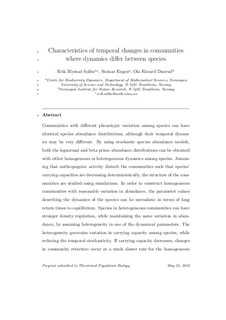Characteristics of temporal changes in communities where dynamics differ between species
Peer reviewed, Journal article
Permanent lenke
http://hdl.handle.net/11250/2398457Utgivelsesdato
2016Metadata
Vis full innførselSamlinger
- Publikasjoner fra CRIStin - NINA [2364]
- Scientific publications [1392]
Sammendrag
Communities with different phenotypic variation among species can have identical species abundance
distributions, although their temporal dynamics may be very different. By using stochastic species abundance
models, both the lognormal and beta prime abundance distributions can be obtained with either
homogeneous or heterogeneous dynamics among species. Assuming that anthropogenic activity disturbs
the communities such that species’ carrying capacities are decreasing deterministically, the structure of
the communities are studied using simulations. In order to construct homogeneous communities with
reasonable variation in abundance, the parameter values describing the dynamics of the species can be
unrealistic in terms of long return times to equilibrium. Species in heterogeneous communities can have
stronger density regulation, while maintaining the same variation in abundance, by assuming heterogeneity
in one of the dynamical parameters. The heterogeneity generates variation in carrying capacity among
species, while reducing the temporal stochasticity. If carrying capacity decreases, changes in community
structure occur at a much slower rate for the homogeneous compared to the heterogeneous communities.
Even over short time periods, the difference in response to deterministic changes in carrying capacity
between homogeneous and heterogeneous community models can be substantial, making the heterogeneous
model a recommended starting point for commu
Community dynamics
Lognormal species abundance model
Beta prime species abundance distribution
Beverton–Holt density regulation
Time dependent parameters
Environmental stochasticitynity analysis.
© 2016 Elsevier Inc. All rights reserved.
